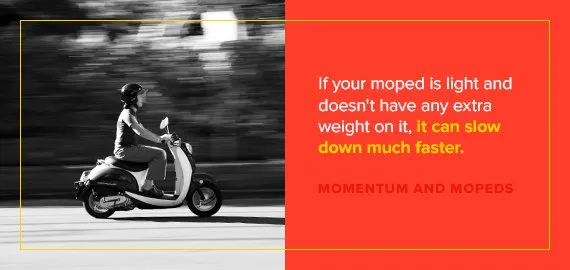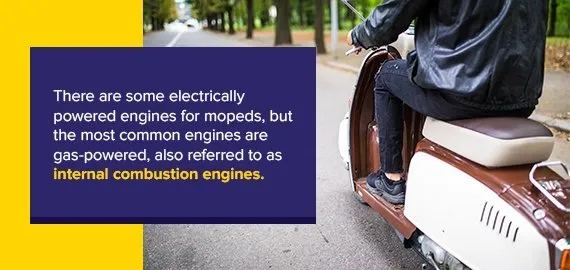Science is everywhere. It guides everything you see in your daily life. You can find science working in your computer and phone and behind your flowers and pet. From living things to inanimate objects, there’s so much science guiding the world, and you can learn more to help you understand it better. One of the most interesting pieces of science you can learn about is how mopeds work.
Mopeds are one of the coolest vehicles around, a sort of a cross between a bike and a motorcycle, with plenty of science helping them run. Learn more about what mopeds are and the science behind how they work.
What Is a Moped?
A moped is an awesome vehicle that many people, like our very own “Dr.” Evan Esquire, like to ride around town. It’s a type of motor vehicle with two wheels and is powered by an engine, and, in some cases, pedals. Older mopeds were commonly built with an engine and pedals in case the engine went out. Nowadays, most mopeds are built with only an engine.
How Do Mopeds Work?
Now that you know what a moped is, we can start to explore the science behind how they work. You probably want to know how they’re powered, especially if you’re ever planning on riding one yourself. Here’s how manually-powered mopeds and engine-powered mopeds work:
Do Mopeds Have Pedals?
Some mopeds do – especially older models! If the moped has pedals on it, it works almost exactly like riding a bike. The rider presses their feet down on pedals and makes the gear they’re attached to spin. The back wheel of the moped will have a gear attached to it as well, with a chain attaching both the pedal gear and wheel gear together. That spinning from pedaling then causes the chain attached to the gear of the wheels to begin to rotate the wheels. This spinning causes the moped to start to move.
Internal Combustion Engines
Just like your family’s vehicle or the bus you ride to school on, a moped runs on an engine that helps power it. While a moped’s engine is usually much smaller than the engines of larger vehicles, it functions in a similar way. There are some electrically powered engines for mopeds, but the most common engines are gas-powered.
Gas-powered engines are also referred to as internal combustion engines. They’re much less tiring for the rider to use, as they don’t require any pedaling. An internal combustion engine is exactly what it sounds like as it uses a controlled explosion to power up the moped.
An internal combustion engine works by spraying gasoline into an engine’s cylinder. This cylinder has something called a piston in it. As the gasoline explodes in the engine, it pushes the piston upwards and makes an attached gear start to spin.
The gear attached to the piston is also attached to another gear that spins a chain. This spinning chain pulls on the moped’s back wheel gear, which causes the tires to start moving, propelling the moped forwards.
If you’re ever looking at mopeds, you might also hear something about cylinders in the engines. Cars will often have four or six cylinders, while mopeds can often only have one or two. Generally, the more cylinders a vehicle has, the more powerful it is.
Brakes
Okay, so you know how a moped is powered now, but you also need to know how it stops. After all, if you couldn’t stop the moped after it gets going, you could be in serious trouble. Mopeds come equipped with brakes to help bring the vehicle to a halt.
Some mopeds come equipped with hand breaks, which function similar to the brakes on a bike. The brake levers are attached to the moped’s handles — one side controls the rear brake, and the other side controls the front brake.
The levers have cables attached to them that lead to the brakes on the rear and front wheels. The cable tugs on the brake, which is made out of rubber. The tugging causes the rubber to clamp down on the wheel, eventually stopping the wheel’s spinning through friction.
Friction refers to the resistance a moving object experiences when it has to move along another surface. It’s what you feel when you rub your hands together and what slows down your ball when you roll it across your yard.

Momentum and Mopeds
Do you think it’s easier for something heavier or light to slow down? Knowing this answer is key to understanding how long it’s going to take your moped to come to a stop. If your moped is light and doesn’t have any extra weight on it, it can slow down much faster. A moped carrying extra weight on it will slow down more slowly, meaning you’ll have to hit the brakes sooner.
The reason for the differences in slowing down the moped comes down to the concept of momentum. Momentum is the strength of a moving object. It’s why it’s more difficult to slow down when you’re running than when you’re simply walking.
Besides affecting how fast a moped slows down, momentum is also how the moped stays upright while moving even though it’s only on two wheels. Just like on a bike, if you try to just sit on the moped without moving, you’ll likely end up on the ground, as it tips over due to gravity. When the moped is moving, momentum keeps the moped upright by overwhelming the gravity.
Make Learning Fun With Science Explorers
Now that you’re an expert in moped science, you’re ready to learn even more science. You can do science kits at home and take classes online to keep learning cool science stuff about the world!
If you’re a parent, you know that when kids find learning fun, they want to keep doing it. Science Explorers lets this principle guide our company as we deliver fun science products and classes to children all around the country. Our blog has plenty of more awesome articles, like how to set up a science lab at home , to give you more ideas for helping your child learn about science.
Sign your child up for one of our after-school virtual STEM clubs to help them discover more about science in a fun environment. We also have awesome subscription kits to let your kids play, explore and learn from the comfort of your home. Have any questions? Contact us today!

